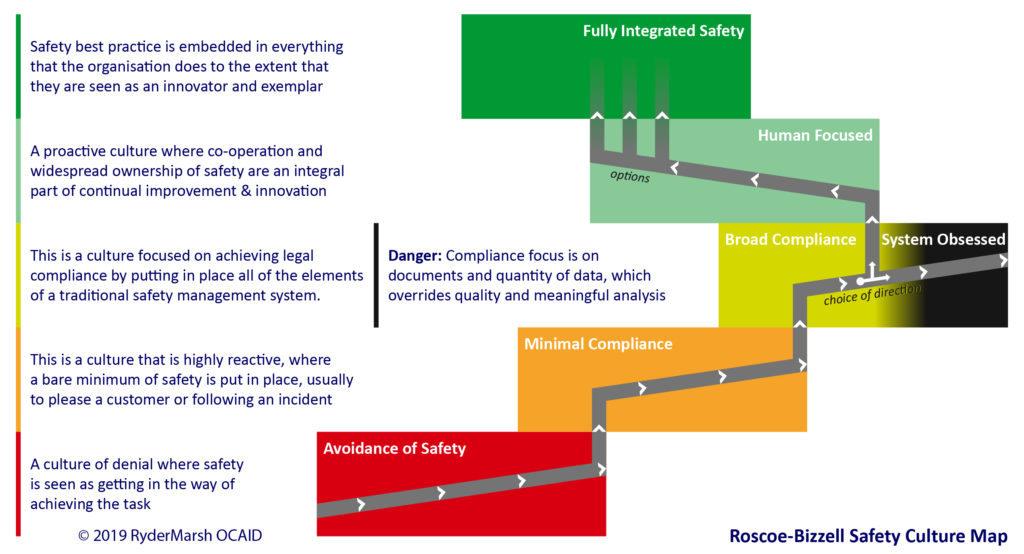
There’s an awful lot been talked and written about Safety Culture, some of well-informed, some well-meaning and some well out of date. So it can be hard to separate fact from fiction. Based on our experience of the most common assertions since the concept first emerged, some 20 years ago, we’re happy to give some in-depth analysis of some of the myths that have grown up.
#1 Safety Culture can’t be measured:
I thought I’d start with one that is actually true, in as much as there’s no actual unit of measurement, however there are ways it can be accurately assessed & benchmarked.
To do that you need to really understand the nature of culture and what goes into it.

Our Universal Culture model draws on sociology and anthropology to show the four major elements of any culture. Universal because you can substitute any number of words for “Safety” in Safety Culture and it still works. The basic idea is that if any of the four elements are significantly different then you have a different culture. What all the arrows indicate is that the elements are all interconnected, so if you make a change in one it effects the other three and each in turn is affected by changes elsewhere.
#2 Safety Culture is all about Behaviours:
#3 Safety Culture is all about Attitudes:
Easiest to deal with these two together. Once you see the model above it is obvious that these are both Myths.
If you do a meta study of all the papers on safety culture over a couple of decades from the nineties you can see most are written either from the perspective of behavioural or organisational psychology. Depending on the background each tends to argue that one or other is the dominant force in determining a culture. There may be cases where either might be true but that’s to ignore the double-headed nature of the arrows in our model as well as the other two elements. The real truth is that culture is a complex interaction of elements and trying to change culture by pulling on any one lever alone leaves you vulnerable to the elastic nature of culture. Generally, if you just use one element then as soon as you stop pulling the others snap the culture back to where it was. Which leads us neatly to
#4 Safety Culture can be changed overnight
This is almost a total Myth– Most changes need time to become embedded. Beliefs are normally the slowest of the four elements to change, often it can take a generation or two for strongly held convictions to change – think political view or religious belief. There is one exception that can bring instant change, unfortunately that is suffering trauma. Since that is exactly what safety systems are designed to avoid, we advocate a slow steady approach addressing the three other elements simultaneously in a co-ordinated and concerted approach.
The trick with changing culture is that it’s best done by lots of small changes over a sustained period of time. The formula we use is 1000 things done by 1000 people over 1000 days. If you can achieve a widespread sustained effort you will end up with a culture that stays where you’ve moved it to.
#5 “We need to get a safety culture”:
We hear this less frequently now but still there’s the occasional plaintive cry, normally heard after one or more “inexplicable” accidents where rules have been broken. So essentially a myth but more often than not it can be taken as a positive statement of intent.
The truth of course is that every organisation has a safety culture it’s just that some are far stronger and/or consistent than others, as the map below indicates. Where do you think your organisation is on the map below?

Actually, many organisations actually have a number of micro-cultures. The differences can be between locations departments, shifts or even the same shift working days and nights. More than that the degree of difference can be either desirable or undesirable and at the same time tolerable or intolerable.
To explain that, if you have two near identical plants operating in two countries with a different native language you will by definition have a different culture. You may also have a different working hours, shift patterns or observe different holidays. A simpler case might be a plant where different equipment is operated on days and nights. Maybe only one line of two runs 7×24, or one is more automated than the other as a capital investment is awaited. The artefacts (tools and equipment in use) are different so two micro-cultures at least. What’s important is to understand the differences and their implications, so that informed business decisions can be taken about what changes will best move the overall culture in the desired direction.
#6 “Safety Culture can be enforced”:
Basically a Myth, what is true though is that leadership can both reinforce and strengthen an existing safety culture. The key issue here is whether or not you’ve got the safety culture you want. If not then the bad news is that what you have is what leadership have asked for over the years and it’s very likely to be reinforced on a daily basis. This may not be explicitly what they said they were after but it comes about as a result of many little actions and things unsaid which staff pick up on and act accordingly. The good news is that we’re adept at picking up on all those little things, we call them “Cultural Clues”, during an assessment and we can always suggest ways to align desire and reality.
If you’re interested in finding out exactly where you are on the map and in relation to other organisations, we’re happy to help. Contact us for an initial discussion or download an overview of our assessment and benchmarking service here.
